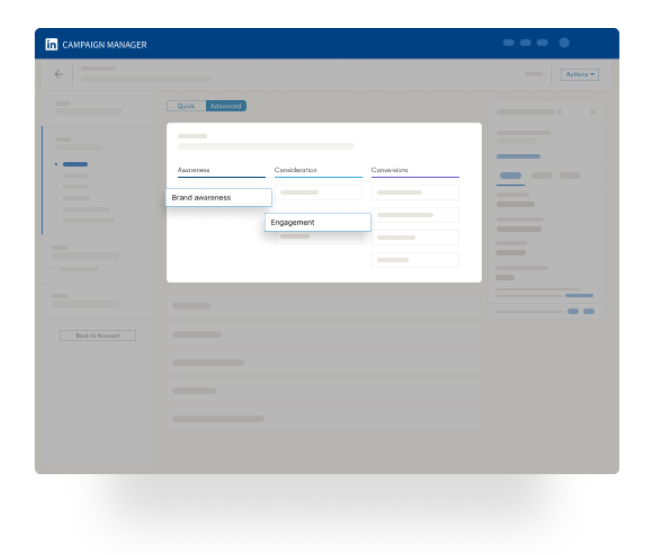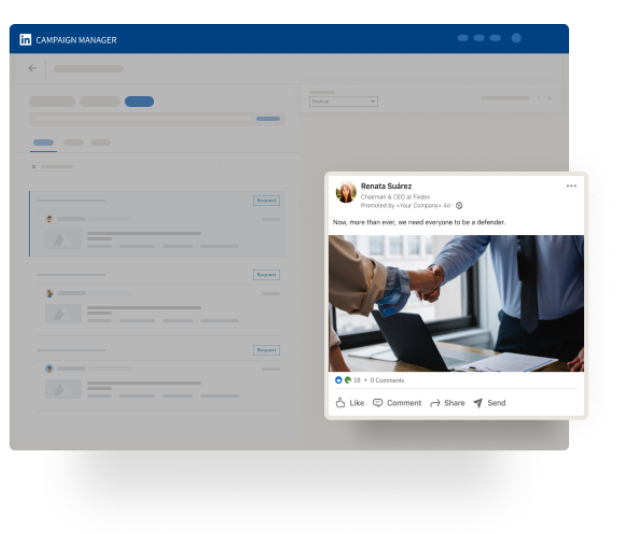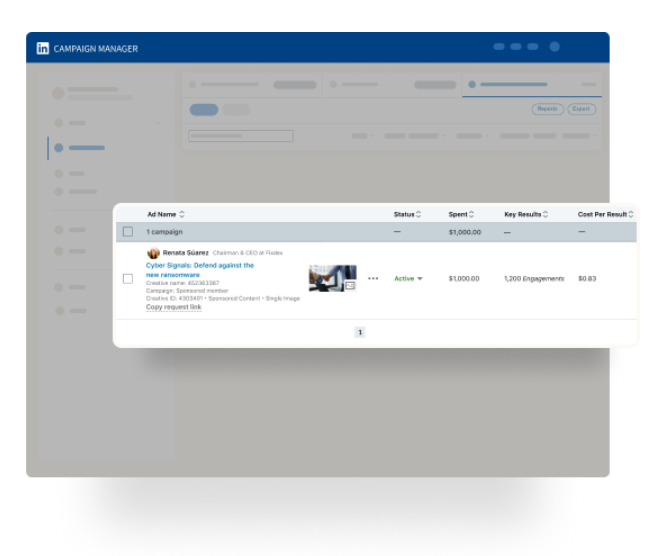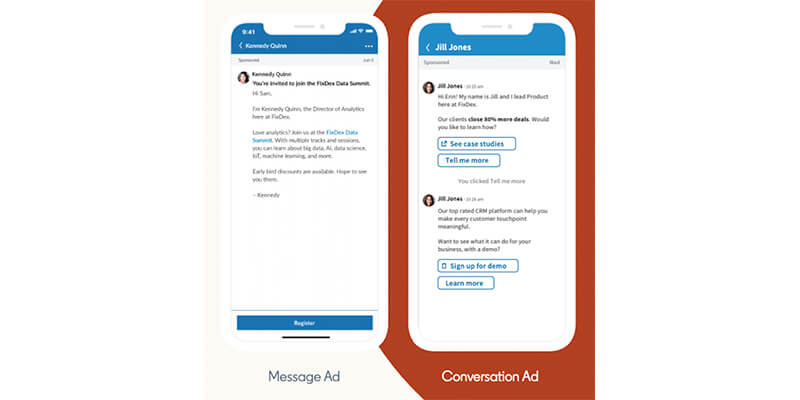2024 Guide to LinkedIn Ads, Benchmarks & Optimizations
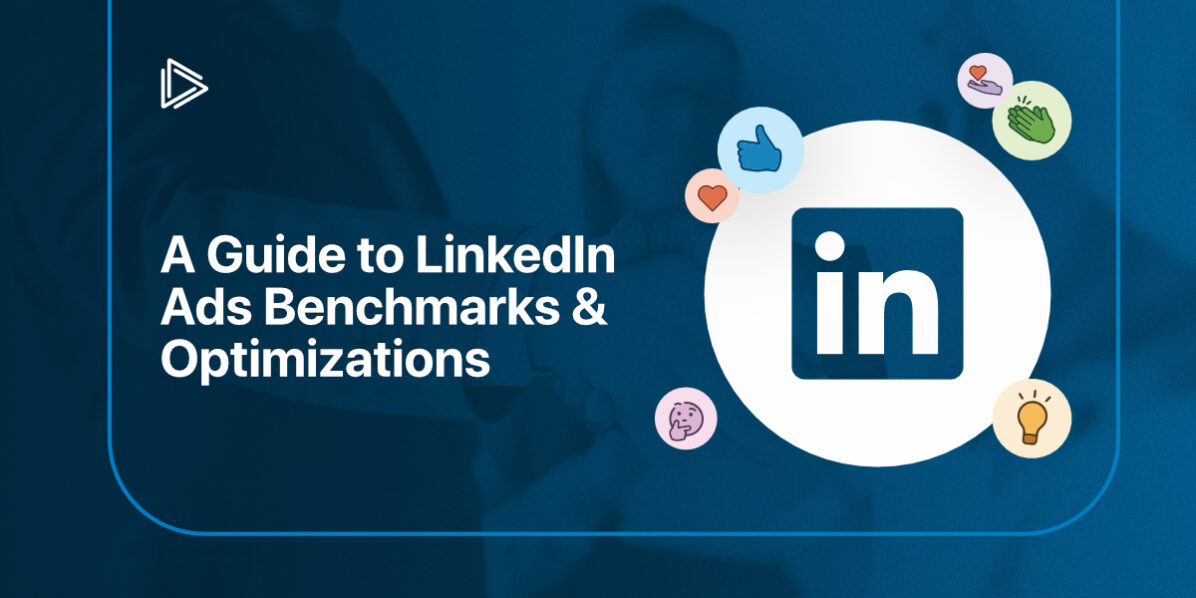
Navigating the dynamic terrain of digital marketing demands significant time and can be stressful. While seeking the latest insights on social media advertising is simple enough, verifying the credibility of the referenced data can prove challenging.
Among the array of social media platforms frequented by savvy marketers—such as Facebook, Instagram, TikTok, or Reddit—LinkedIn stands out for its tailored approach to professionals and businesses. Though it may exude a more formal demeanor compared to its counterparts, this is far from a drawback. In fact, LinkedIn presents marketers with an audience primed with professional interests and career-focused mindsets. This makes them particularly receptive to offers from both B2B enterprises and select B2C ventures.
Similar to its peers, LinkedIn continually refines its advertising platform to remain at the forefront of innovation. Fortunately, we’ve compiled essential insights (and pain points) that every LinkedIn marketer should leverage for optimal ad planning and performance.
Table of Contents
LinkedIn Ad Types
Before diving into optimal KPI benchmarks, it’s essential to review what ad types are currently available on LinkedIn. New LinkedIn products are occasionally released, so this list (compiled in January 2024) is subject to change.
Each ad type has its pros and cons, so considering these is essential to creating successful campaigns that resonate with the right audiences. Need help mapping out your LinkedIn strategy? Our team of experts has your back.
1. Sponsored Content
Sponsored Content ads, sometimes called “native content ads,” look like organic posts in your audiences’ news feed. There are several varieties of Sponsored Content ads now available on LinkedIn:
- Single image ads
- Document ads (🚨NEW!)
- Video ads
- Carousel ads
- Event ads
- Thought Leader ads (🚨NEW!)
These ads are highly effective because of their organic appearance that fits seamlessly into a user’s news feed, helping to support a high-quality user experience while still getting your message across. Let’s break down each one, as there are several options:
- Single image ads: These feature one static image contextualized with text.
- Document ads: This newer format allows advertisers to share insights or data as a document with their audience – either freely or through a Lean Gen Form gate.
- Video ads: These feature one video contextualized with text.
- Carousel ads: This ad type uses 2-10 images the user can swipe through. Each card features an image and text.
- Event ads: This ad lets an audience know about an upcoming event, including webinars and in-person functions.
- Thought Leader Ads: Another new format, Thought Leader Ads are similar to branded content ads or boosting posts on other platforms like Instagram or TikTok.
Sponsored Content ads are a great starting point for building top-of-funnel awareness. We recommend them for awareness and consideration campaigns, especially if you are new to LinkedIn Ads and are unsure of where to begin.
Single Image Ad Specs
File Type: Image must be jpg, png or gif, and less than 5 MB in size.
Image Ratios:
- 1.91:1 (horizontal; min 640×360 pixels; max 7680×4320 pixels)
- 1:1 (square; min 360×360 pixels; max 4320×4320 pixels)
- 1:1.91 (vertical; min 360×640 pixels; max 4320×4320 pixels). Vertical images will not deliver to desktop but are best for mobile-targeted campaigns.
Ad name: (optional): 255 characters
Headline: 70 characters
Introductory text: 150 characters recommended (for mobile optimization; but can be longer for desktop)
Description: 70 characters (only required if you have the ad running on LinkedIn Audience Network)
Landing page URL: uses the http:// or https:// prefix.CTA Buttons: Apply (for hiring ads), Download (for distributing white papers or other documents of interest to the audience), View Quote, Learn More, Sign Up, Subscribe (for newsletters), Register (for events), Join, Attend or Request Demo
Document Ad Specs (🚨NEW!)
File Type: MP4 file format with an AAC or MPEG4 audio format. Videos must be at least 3 seconds long and no longer than 30 minutes.
File size: Max 100 MB and 300 pages
File amount: Up to five documents
Word limit: 1 million
Videos and animations: These aren’t supported in Document Ads. If uploaded, they will display as static images instead.
Hyperlinks: Only clickable if user downloads the document.
PDFs: Must be flattened or merged if containing multiple layers. Those with multiple sized pages must be fit to same page size.
Ad name (optional): 255 characters
Headline: 70 characters. Headline will be filled with file name, by default, but can be replaced by custom headline.
Introductory text: 150 characters recommended (for mobile optimization; but can be max of 600 for desktop). URLs can be included but will be shortened if longer than 23 characters.CTA buttons: Apply, Download, View Quote, Learn More, Sign Up, Subscribe, Register, Join, Attend, and Request Demo.
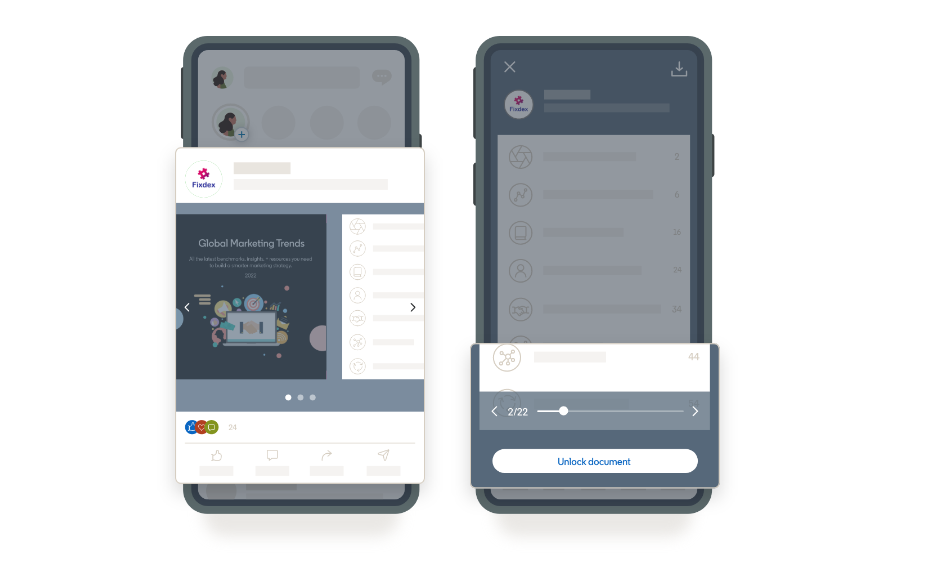
https://business.linkedin.com/marketing-solutions/native-advertising/document-ads
Video Ad Specs
File Type: MP4 file format. Sound rate must be less than 64 KHz. Videos must be at least 3 seconds long and no longer than 30 minutes.
Video Ratios:
- 16:9 (landscape; 1.78)
- 1:1 (square)
- 4:5 (vertical)
- 9:16 (vertical)
Video File Size: More than 75 kb but no more than 200 mb
Width: Max 1920 px; min 360 px
Height: Max 1920 px; 360 px
Video Thumbnail File Format: JPG or PNG
Video Thumbnail Max File Size: 2 MB Video
Thumbnail Aspect Ratio & Resolution: Match video
Ad name (optional): 255 characters
Headline: 70 characters; max of 200 characters
Introductory text: 150 characters recommended (for mobile optimization; but can be longer for desktop); max of 600 characters
CTA buttons: Apply, Download, View Quote, Learn More, Sign Up, Subscribe, Register, Join, Attend, and Request Demo.
Landing page URL is required. Prefix must start with http:// or https://.

Carousel Ad Specs
File Type: Image must be jpg, non-animating gif or png. (Video is not currently supported by Carousel Ads)
Image ratios: 1:1 (square; max dimension of 4320×4320 px)
Ad name (optional): 255 characters
Card Headline: 45 characters
Introductory text: 255 characters
Landing Page URL: uses the http:// or https:// prefix
CTA buttons: Apply, Download, View Quote, Learn More, Sign Up, Subscribe, Register, Join, Attend and Request Demo. ONLY available for Carousel Ads that use Lead Gen forms.

Event Ad Specs
File Type: Image will be pulled from the organic event’s page
Image Ratio: 4:1 (will be pulled from the organic event’s page)
Ad Name (optional): 255 characters)
Introductory Text: 150 characters recommended for mobile device optimization (but can be up to 600 characters)
Event URL: Required and must be the URL to a LinkedIn page.

Thought Leader Ad Specs (🚨NEW!)
File Type: Image or video may be used. For image, follow the single image ad specifications for image files. For video, follow the video ad specifications for video files.
CTA button: None available for Thought Leader ads
URL Requirements: URLs are not added to this ad type. However, any URLs included in the original post will remain hyperlinked.
Please note: You cannot promote a post that included a LinkedIn article or newsletter, multiple images, polls, or documents.
2. Conversation Ads
Using messaging in your marketing campaigns is a fantastic way to create more intimate communication between your brand and your ideal consumer about your products or services while targeting users further down the conversion funnel. Insider Intelligence even predicts that in 2024, social media users will further embrace private, person-to-person contact over public posting.
LinkedIn previously offered two options for Sponsored Messaging: Conversation Ads and Message Ads. Now, options have been streamlined into a single ad type: Conversation Ads. These ads will be served as a “focused” message in LinkedIn’s native messaging platform where you only pay for Conversation Ads that are opened.
Conversation Ads and Message Ads Specs
Banner image (optional; only available on desktop): jpg or png files, smaller than 2MB; max 300×250 px
Ad name (optional): 255 characters
Message subject: 60 characters; subject line appears as the first line in the user’s Focused inbox. Shorter is better!
Message text: 2,500 characters
Custom footer: 2,500 characters; typically used for required T & Cs.
Intro message: Automatically populated with a sample message that you can change. Macro support is available for customized messages (first and last name, company name, job title, and industry); Max 8,000 characters
Main message: Max 8,000 characters; rich text like bulleting, italics, and bolding are available, but it is recommended not to overuse. Automatically populated with a sample message that you can change. Macro support is available for customized messages (first and last name, company name, job title, and industry)
Optional image: Max 250×250 px; mobile may render the image differently depending on the platform and phone; file type must be JPG or PNG; Max file size: 5 MB
Call-to-action button text: 25 character limit
Maximum CTA buttons per message: 5
Landing page URL: uses the http:// or https:// prefix
3. Lead Generation Ads
When your business is looking to collect more direct leads look no further than Lead Gen Form Ads! Lead Gen Form Ads make filling out a form easy for users by auto-filling specific fields tied to their LinkedIn profile. These ads are served to users in their Newsfeed, in their LinkedIn messages, and on their desktop as Text Ads. We recommend using Lead Gen Form Ads on “warm” audiences – those familiar with your brand or offerings that are more prepared to convert.
Lead Gen Forms Specs
File Type: There are no images or videos used in lead gen forms
Form name: 256 characters
Offer headline: 60 characters
Offer detail: 160 characters (optional)
Privacy policy: 2,000 characters
Call-to-action: 20 characters
Confirmation message: 300 characters
Landing page URL: uses the http:// or https:// prefix.
There are a variety of form fields to select from. The fewer fields you can include, the better, making the process short and straightforward for the user. The recommended number of fields is 3 to 4.
- Min fields: 3
- Max fields: 12
- Form fields you may include: First name, Last name, Email address, LinkedIn profile URL, Phone number, City, State/Province, Country/Region, Postal/Zip code, Work email, Work phone number, Job title, Function, Seniority, Company name, Company size, Education degree, Field of study, University/School, State date, Graduation date, and Gender.
- There are a maximum of three custom questions you can ask. These are optional. Each custom question has a 100 character limit.
4. Text Ads
These ads are similar to what you see from SEM ads, except housed on the LinkedIn platform. You can set PPC or CPM caps to control budgets and choose whether to pay for clicks or impressions.
We recommend these ads for mid-funnel campaigns to generate traffic or leads or when trying to gain more organic followers to your company page. However, these ads are not as front-and-center on the channel as other LinkedIn ad types and are not recommended for conversion campaigns or flashy awareness efforts.
Text Ads Specs
File Type: Image must be a jpg or png, and less than 2MB in size.
Image ratios: no longer than 100 x100 pixels
Headline: 25 characters
Description: 75 characters
Landing page URL: uses the http:// or https:// prefix
CTA buttons: Apply, Download, View Quote, Learn More, Sign Up, Subscribe, Register, Join, Attend, and Request Demo
Follower Ads Specs
Logo: Image must be a jpg or png, and less than 2 MB in size
Image ratios: no larger than 100 x 100 pixels
Headline: 50 characters
Description: 70 characters
Company name: 25 characters
CTA buttons: Visit careers, visit company, visit jobs
5. Dynamic Ads
Dynamic Ads are similar to Text Ads but feature personalization options tailored to your audience. There are two types of Dynamic Ads: Spotlight and Follow – but both are very similar and are like templates for Dynamic ads that are focused on driving traffic to product pages or gaining LinkedIn followers, respectively. Because of this, we will not break them down separately in the specifications below.
Because these ads can grab the user’s attention through personalization, we recommend them for upper-funnel campaigns to build awareness of your brand. However, like Text Ads, they are not as front-and-center on the channel as other LinkedIn ad types and are not recommended for bottom-funnel or conversion campaigns.
Text Ads Specs
File Type: Image must be a jpg or png, and less than 2MB in size.
Image ratios: no longer than 100 x100 pixels
Background Image (optional; Spotlight Ads only): Image must be jpg or png, and less than 2 MB in size.
Headline: 25 characters
Description: 75 characters
Landing page URL: uses the http:// or https:// prefix
CTA buttons: Apply, Download, View Quote, Learn More, Sign Up, Subscribe, Register, Join, Attend, and Request Demo
Description Options (Follow Ads only): LinkedIn give you a fixed set of headlines and descriptions to choose from. This allows LinkedIn to personalize the copy to the user. Check out the available options here.
LinkedIn Ad Benchmarks
Using a sampling of industry published benchmarks, our historical data, and current industry trends we’ve developed a list of LinkedIn benchmarks for your paid campaigns. Leverage this as a comparison tool when evaluating campaign performance.
Four things are essential to keep in mind when referencing our LinkedIn ads benchmarks:
- These metrics may vary depending on your audience’s demographics like industry, seniority, geographic location, etc.
- The COVID-19 pandemic drastically changed behaviours at the beginning of 2020. While it is expected that metrics will normalize throughout 2022, historical data from 2021 may be considered outliers to typical performance. We’ve tried to minimize using those numbers while creating these benchmarks.
- IOS 14.5 has taken away valuable advertising data, causing CPMs to rise and some ad performance to suffer. This update does not mean that social media ads don’t work or aren’t a smart investment – it simply means that you may have to pay more to reach the same audience.
- It’s always good to maintain your list of benchmarks using historical data from your campaigns. What’s “normal” for one business may never fall within reach of another, but that doesn’t mean the campaign wasn’t successful. Ultimately, the most reliable success marker is seeing a return on ad spend or reaching marketing goals through your campaigns.
Let’s jump in to our 2024 LinkedIn paid social benchmarks:
- Upper Funnel (Awareness & Reach):
- CTR: 0.53%
- VTR: 41%
- Middle Funnel (Traffic & Engagement):
- CTR: 1.33%
- VTR: 43%
- Lower Funnel
- CTR: 0.49%
- VTR: 28%
- Cost Per Lead (CPL): $232.07
- Conversation Ads (all funnel):
- Open Rate: 48%
- CTR on Opens: 1.72%
- Cost Per Open (CPO): $0.80
6 Ways to Optimize Your LinkedIn Ad Campaigns
Now that we’ve reviewed the ad unit options and a few 2024 benchmarks for LinkedIn ads, how can you ensure your campaigns perform their best? Fear not, we’ve compiled a few of our most successful tips and tricks for you to apply today:
Choose the right ad type for your campaign objective: It’s easy to get excited about utilizing a new or flashy ad type when building your campaigns but making sure all aspects of the campaign align with your overall objective is crucial. Here’s a refresher on the objectives available for LinkedIn campaigns:
Awareness: This is the top of the conversion funnel. Typically, upper-funnel campaigns help to create brand awareness. These campaigns include prospecting through Lookalike audiences based on previous converters or developing new core audiences targeting specific demographics and business traits. Your goal here is not to convert or gain leads right away but instead to “warm” a “cold” audience likely to be unfamiliar with your brand, products, or services.
Ad Types Optimized for Awareness Campaigns: Sponsored Content, Document Ads, Thought Leader Ads, and Dynamic Ads
Consideration: The middle of the funnel, where product research and consideration occur, is a turning point for many in your audience. This stage is where your audience decides whether to pursue more information about your brand. When running a Consideration campaign, LinkedIn gives you three objectives: Website visits, Engagement, and Video views. Here, you’d want to target audiences created from previous website visitors or those who have engaged with your top-funnel campaigns. This is not the place to teach a “cold” audience about your brand.
Ad Types Optimized for Consideration Campaigns: Sponsored Content (especially Video, Event, Document, Thought Leader, and Carousel Ads), Conversation Ads
Conversions: The bottom of your funnel is geared towards conversions and re-engagement with current and previous clients. LinkedIn offers Lead generation, Website conversions, and Job applicants as three conversion objectives to use. The audiences you got after here are in an action-oriented mindset and should be ready to convert if you’ve timed your impressions right.
Ad Types Optimized for Conversions Campaigns: Lead Gen Forms, Conversation Ads
Keep copy short and sweet: As you can imagine, many engaged on LinkedIn are also busy job searching, catching up with their networks, or dreaming about a day they’re posting about their next dream gig. On top of that, the digital age has influenced attention spans, especially when using mobile devices. With the significant rise in CPMs since iOS 14.5 in 2021, it’s never been more critical to make it count when your ad reaches your target audience.
Reading your ads shouldn’t be a chore. You want to convey your message and call to action swiftly while still making an impact. As a recommendation, try to limit each part of copy in your ads to 150 characters or less (unless there is a shorter character limit, obviously). Your messaging should also draw the audience in and always keep in mind the overarching campaign objective.
Don’t Discount Emojis: These tiny, but powerful, emoticons share many meanings in one little character. While emojis may seem too casual for ads targeted at professionals, their use has permeated almost every facet of modern communication – including the business world. Just remember to use them sparingly and don’t go overboard. More emojis continue to be added to keyboards worldwide, so it’s wise to stay on top of the latest ones available by following The Unicode Consortium and any releases they may have in the future.
Don’t be afraid of getting creative – with your creative: LinkedIn is a professional social media channel doesn’t mean your ads must be dry and static. You can apply many of the creative optimizations used on Facebook and Instagram can be applied here with similar results. The rule of thumb is to make sure your creative effectively communicates your brand and your message.
Some ways to optimize your creatives include:
Video: Short videos are eye-catching and grab your audience’s attention. When using these assets, include branding within the first :03s if you are trying to raise brand awareness. If your video features audio dialogue, add captions so that mobile users with silent phones can still engage and those with hearing disabilities can receive the message.
Lastly, focus your animation on the advertised product or service to ensure your message gets across clearly.
Static Images: One picture can communicate a lot – Don’t be tempted to add a lot of text to your graphics. It muddies up the creatives and turns off the audience. LinkedIn won’t penalize ads using excessive text in the images, but using excessive text still creates a poor-performing ad.
LinkedIn Ads Aren’t Just for B2B –
Believe it or not, some D2C brands may also benefit from LinkedIn Ads, which is especially true after the pandemic sent office workers home to carry out their jobs. Google Trends showed a significant spike in searches for “work from home” in March 2020, and as many employees continue to work from home full-time, or offices have instituted hybrid schedules, search volume for this crucial phrase continues to be high. Users have home office furniture and supplies top of mind, and e-commerce brands selling these items would greatly benefit from ads on LinkedIn. Other products and services that may benefit include blue-light filtering glasses, benefit providers for self-employed individuals, financial advisors, productivity or organization applications, and universities offering post-graduate education.
Test, Test, Test!
The most successful way to determine the right strategy for your brand is by testing. Continued testing allows for increasing campaign efficiency over time – much more efficient than any outside advice or skills could provide. How is this so? It’s because testing develops strategy that is fully-customized to your brand and your goals.
But many advertisers still do not regularly test because they lack the knowledge to plan and execute properly. If you are looking for further information on testing LinkedIn ads, see the article here. Pro tip: don’t forget that a failed test still yields actionable insights.
We hope this guide will give you confidence in when building your own LinkedIn campaigns. In addition, feel free to bookmark this article to reference in the future when you most need it, and continue to browse our blog for more insider tips and tricks.
Looking for more help, or a customized solution to LinkedIn Ads? AdParlor is well-equipped to create successful paid media campaigns across LinkedIn and other social media channels. Send us a note and we’ll be in touch.

